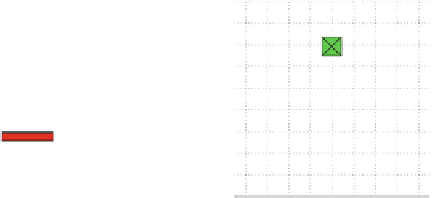Graphics Reference
In-Depth Information
(a)
(b)
(c)
Accumulated trajectories
Accumulated trajectories
Accumulated trajectories
45
45
45
40
40
40
Goal
Goal
G
o
al
35
35
35
30
30
30
25
25
25
20
20
20
15
15
15
10
10
10
5
5
5
Start
Start
Start
0
0
0
021150 −
−
−
−
021150 −
−
−
−
021150 −
−
−
−
y[m]
y[m]
y[m]
Fig. 4.15
Door experiment:
top-down
view of Monte Carlo simulation with 100 runs with
a
no
pose noise,
b
additive white noise in x and y (
≤
15 cm),
c
random walk bias in x and y (13.4 cm
/
s,
random direction for each run)
This changed when a drifting pose estimate was simulated as shown in Fig.
4.15
c.
To simulate a random walk bias on the position estimates, a fixed position offset of
1
s with a 100 Hz sim-
ulation rate) in a random direction within the x/y plane was defined at the beginning
of each run, and added as a pose offset prior to each planning step. In this experiment,
the vehicle kept a stable orientation to maintain correct heading, which we assume
closely related to real flight experiments, since roll and pitch would be stabilized
around a drift-free gravity vector and yaw can be assumed to be measured locally
drift free by an onboard magnetometer or a vision-aided pose estimation approach.
Since all world point coordinates drift with the amount of bias on pose, the goal
cannot be reached and serves as a desired flight direction indicator.
The vehicle was able to pass the obstacle without a collision in 96 % of all cases.
Collisions only occurred when the vehicle was already within the opening and drifting
sideways, so that the camera could not see the closing in obstruction.
Figure
4.16
illustrates the performance of our navigation system in a real-world
scenario. We implemented our algorithm onboard an Asctec Pelican quadrotor which
was equipped with an Intel Core2Duo, 1.86 GHz processor and conducted flight
experiments in a test forest (Fig.
4.6
).
Our system setup used the sensor fusion approach from [
63
] for pose estimation.
It fuses IMU and position updates from a visual SLAM algorithm (Parallel Tracking
and Mapping (PTAM) [
30
]) that uses images from a downward-looking camera (752
×
.
3 cm (a 10 % drift when operating at maximum speed of 1
.
3m
/
480, grayscale, 100 FOV).
To generate stereo disparity maps, we mounted a stereo camera system [
20
]ontop
of the quadrotor that included an embedded OMAP3730 to off-load the calculation
of real-time disparity maps (376
240, 25 Hz, 12 cm baseline, 110 FOV) from the
main processor, which only performed postprocessing of disparity maps within the
stereo vision pipeline.
In this setup, the pose estimation framework used 59 % of the total resource
(camera and PTAM (30 Hz) 48 %, pose filter (30 Hz) 11 %), stereo postprocessing
×


























































































































































































































































































































































































































































































































































































































































































































































































































































































































































































































































































































































































































































































































































































































































































































































































































































































































































































































































































































































































































































































































































































































































































































































































































































































































































































































































































































































































































































































































































































































































































































































































































































































































































































































































































































































































































































































































































































































































































































































































































































































































































































































































































































































































































































































































































































































































































































































































































































































































































































































































































































































































































































































































































































































































































































































































































































































































































































































































































































































































































































































































































































































































































































































































































































































































































































































































































































































































































































































































































































































































































































































































































































































































































































































































































































































































































































































































































































































































































































































































































































































































































































































































































































































































































































































































































































































































































































































































































































































































































































































































































































































































































































































































































































































































































































































































































































































































































































































































































































































































































































































































































































































































































































































































































































































































































































































































































































































































































































































































































































































































































































































































































































































































































































































































































































































































































































































































































































































































































































































































































































































































































































































































































































































































































































































































































































































































































































































































































































































































































































































































































































































































































































































































































































































































































































































































































































































































































































































































































































































































































































































































































































































































































































































































































































































































































































































































































































































































































































































































































































































































































































































































































































































































































































































































































































































































































































































































































































































































































































































































































































































































































































































































































































































































































































































































































































































































































































































































































































































































































































































































































































































































































































































































































































































































































































































































































































































































































































































































































































































































































































































































































































































































































































































































































































































































































































































































































































































































































































































































































































































































































































































































































































































































































































































































































































































































































































































































































































































































































































































































































































































































































































































































































































































































































































































































































































































































































































































































































































































































































































































































































































































































































































































































































































































































































































































































































































































































































































































































































































































































































































































































































































































































































